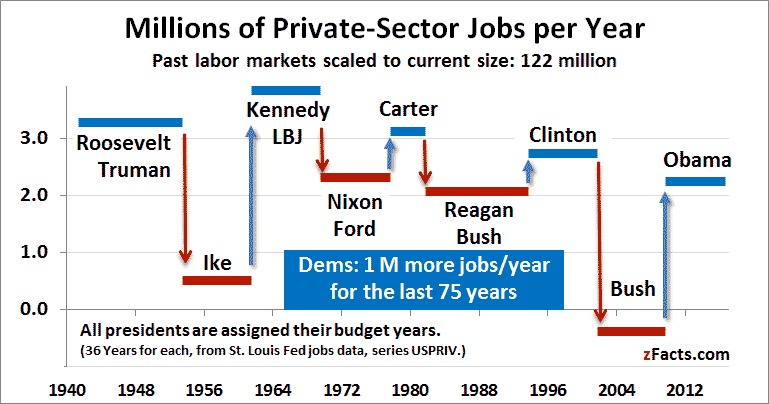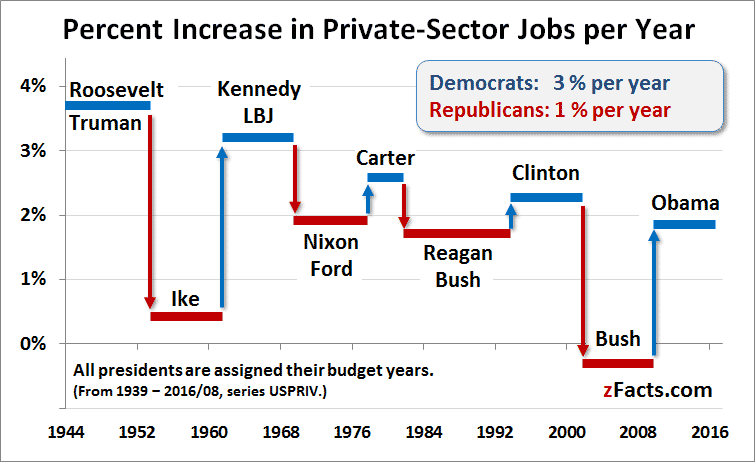 This this graph is designed to display the difference in job creation in terms of jobs instead of percentages. It doesn’t make sense to compare Ike to Obama without adjusting for the fact that the job market was about three times smaller in Ike’s day, so naturally he would create far fewer jobs per year.
This this graph is designed to display the difference in job creation in terms of jobs instead of percentages. It doesn’t make sense to compare Ike to Obama without adjusting for the fact that the job market was about three times smaller in Ike’s day, so naturally he would create far fewer jobs per year.
To compensate, all of Ike’s numbers are scaled up by about three times (but he still created very few jobs), so it’s as if the country were as big back then as it is now. This was done in all cases. The result is that the “one million jobs per year” difference would be right if the country had been the size it is now for the whole 75 years. And that’s the number that’s relevant for comparing the parties in today’s world.

Steal this Graph (and the data too)
We know why the Republicans lose this horse race. And for those of you who might think this is “liberal bias,” I base the following analysis on a super-conservative economist—a favorite with NewsMax and other right-wing media.
Three types of policies are required to fight a recession and Republicans oppose the first two while the Democrats favor them. (Neither party does much about the third policy.) According to conservative economist Peter Morici (video, July 2009), these three policies are:
- “We absolutely had to have a stimulus package.”
- “turning the banks around”
- “dealing with the trade deficit.”
Stimulus. He emphasizes the first most, and estimates that:
“The [Obama] stimulus package … will probably create two to 2.5 million jobs throughout the economy. It’ll be in things like construction, government service, retrofitting buildings for energy efficient usage, medical records and so forth, however it’s really going to be throughout the economy, and it will likely deal with about half of the unemployment created by the recession.” —Morici
So this is the most important jobs creation tool in a severe recession and all Democrats voted for it, while no House Republicans did and only three Republican Senators did. This is the primary reason Republicans are bad at job creation. They either don’t understand that when the government buys goods and services, people are hired to provide these, or they would rather leave them unemployed than have the government help out.
This view, that the government should not create jobs, has been a constant Republican view for at least the last 90 years or more, and that explains why they have consistently had “bad luck” creating jobs.
Banks. Now consider point 2, “turning the banks around.” Consider TARP, the bank bailout that President Bush rammed through Congress in 2008. Had that failed we would have had a second depression. In spite of such desperate circumstances and the pleadings of their president, House Republicans preferred calamity to saving the banks 108 to 91. This attitude extends to similar policies such as saving the US auto industry. Republicans preferred to lose all those jobs (after all they were just union workers) than to let the government help out.
Trade deficit. The third leg of Peter Morici’s jobs policy is fixing the trade deficit. In June, 2014 he explained: “If we could solve the trade deficit riddle we could solve the jobs problem. … That was a problem during the Bush years and it remains a problem during the Obama years. It’s not a partisan issue.” So this is likely not a factor explaining the the job-creation graph.
Reducing regulation is the Republican’s number one theory of how to create jobs, and it completely misses the point. Did G. W. Bush suddenly issue regulations that caused millions of layoffs? Did Obama then rescind these regulations to hire back 10 million workers? This theory makes no sense, and focusing on it causes Republicans to fail to take effective action. Once again this gives Democrats an advantage in creating jobs.
A question of timing. G. W. Bush took office in January and a recession started in March. Naturally he blamed it on Clinton. In essence that’s right. Clinton’s expansion lasted exactly 10 years, the longest on record, but the dot-com bubble burst before Bush took office, and there is nothing a president can do in a month or two, or even nine, to stop a big recession that is already underway. Here’s what conservative economist Peter Morici told us in May or June of 2009.
“Over the next six months, the economy is going to continue to shed jobs, because its simply going to take some time for the stimulus package to have some traction. In 2010 we can look forward to an economic recovery.”
So he is saying that even though Obama passed his stimulus package in record time, it is going to be 2010 before he can stop the recession he inherited. So the job losses during the first year are in no way his fault.
In spite of this, I give him and all other presidents a pass for only the first 8.3 months of their term. That is not an arbitrary choice; it is the time covered by the previous president’s last fiscal year which runs from Sept. 30 to Sept. 30, and so covers Jan 21 to Sept 30 of the new president’s first term. Perhaps they should get a little longer pass, but any other choice would seem arbitrary. It makes sense to hold Presidents accountable for the own fiscal years.

